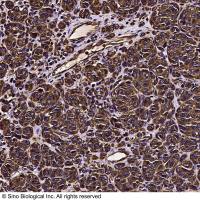Detecting Ubiquitinated T-Cell Antigen Receptor Subunits by Immunoblotting
互联网
579
An increasing number of transmembrane proteins are being identified as substrates for ubiquitination. Ubiquitin is a highly conserved 76 amino acid polypeptide that is covalently added to proteins as monomers or chains as a consequence of the formation of an isopeptide linkage between the carboxyl terminus of ubiquitin and the ε-amino groups of lysine side chains of target proteins (reviewed in ref. 1 ). Classically, modification by ubiquitin results in a change in migration on SDS-PAGE such that modified proteins take on a ladder-like appearance with a periodicity of ∼8 kDa. Alternatively, ubiquitinated species can appear as a high molecular weight smear. Our current understanding is that, for transmembrane proteins, this modification may occur while in the endoplasmic reticulum (ER) or at the plasma membrane. In both cases ubiquitination occurs on the cytosolic (intracellular) domain. Thus, this modification should not affect recognition by antibodies directed against luminal (or extracellular) domains.









